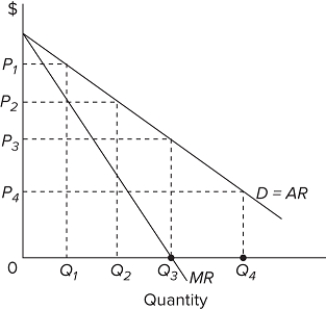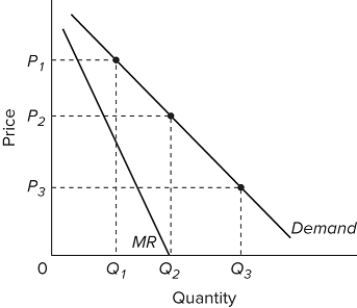Correct Answer

verified
Correct Answer
verified
Multiple Choice
The region of demand in which the monopolist will choose a price-output combination will be
A) inelastic because, as price declines and output increases, total revenue will increase.
B) inelastic because, as price declines and output increases, total revenue will decrease.
C) elastic because, as price declines and output increases, total revenue will decrease.
D) elastic because, as price declines and output increases, total revenue will increase.
Correct Answer

verified
Correct Answer
verified
True/False
In the short run a pure monopolist will charge the highest price the market will bear for its product.
Correct Answer

verified
Correct Answer
verified
Multiple Choice
If a monopoly is faced with competition from foreign multinational corporations or from potential new entrants, then it would probably
A) raise price and reduce output.
B) reduce price and raise output.
C) start operating at the inelastic portion of its demand curve.
D) increase production so that MR > MC.
Correct Answer

verified
Correct Answer
verified
Multiple Choice
Which of the following is not a barrier to entry?
A) patents
B) X-inefficiency
C) economies of scale
D) ownership of essential resources
Correct Answer

verified
Correct Answer
verified
Multiple Choice
 Refer to the graph, which shows the revenue curves for a monopolist. At what output level is demand inelastic?
Refer to the graph, which shows the revenue curves for a monopolist. At what output level is demand inelastic?
A) Q₁
B) Q₂
C) Q₃
D) Q₄
Correct Answer

verified
Correct Answer
verified
Multiple Choice
Barriers to entry
A) usually result in pure competition.
B) can result from government regulation.
C) exist in economic theory but not in the real world.
D) are typically the result of wrongdoing on the part of a firm.
Correct Answer

verified
Correct Answer
verified
Multiple Choice
The nondiscriminating pure monopolist's demand curve
A) is the industry demand curve.
B) shows a direct or positive relationship between price and quantity demanded.
C) tends to be inelastic at high prices and elastic at low prices.
D) is identical to its marginal revenue curve.
Correct Answer

verified
Correct Answer
verified
Multiple Choice
Answer the question on the basis of the accompanying demand schedule.  The marginal revenue obtained from selling the third unit of output is
The marginal revenue obtained from selling the third unit of output is
A) $9.
B) $1.
C) $6.
D) $8.
Correct Answer

verified
Correct Answer
verified
Multiple Choice
If a monopolist were to produce in the inelastic segment of its demand curve,
A) total revenue would be at a maximum.
B) marginal revenue would be positive.
C) the firm would not be maximizing profits.
D) it would necessarily incur a loss.
Correct Answer

verified
Correct Answer
verified
True/False
Because of the ability to influence price, a pure monopolist can increase price and increase volume of sales simultaneously.
Correct Answer

verified
Correct Answer
verified
Multiple Choice
Suppose that a pure monopolist can sell 7 units of output at $9 per unit and 8 units at $8.50 per unit. For the monopolist to profitably produce and sell the eighth unit of output, its marginal cost must be anywhere at or below
A) $9.
B) $8.50.
C) $6.50.
D) $5.00.
Correct Answer

verified
Correct Answer
verified
Multiple Choice
Which of the following statements is correct?
A) In the short run, the pure monopolist will maximize total profits by producing at that level of output where the difference between price and average total cost is greatest.
B) In the short run, the pure monopolist will charge the highest price it can get for its product.
C) Because of its ability to set its own price, the pure monopolist can increase price and increase its volume of sales simultaneously.
D) Pure monopolists do not always realize positive profits, sometimes they suffer losses.
Correct Answer

verified
Correct Answer
verified
Multiple Choice
 Refer to the graphs of D and MR for a monopolist. Which of the following statements is true?
Refer to the graphs of D and MR for a monopolist. Which of the following statements is true?
A) Demand is elastic at a price of P₁.
B) Demand is inelastic at a price of P₂.
C) The price elasticity of demand is constant over the entire demand curve.
D) Demand is unitary-elastic over the entire demand curve.
Correct Answer

verified
Correct Answer
verified
Multiple Choice
The demand curve confronting a nondiscriminating pure monopolist is
A) horizontal.
B) the same as the industry's demand curve.
C) more elastic than the demand curve confronting a competitive firm.
D) derived by vertically summing the individual demand curves for the buyers.
Correct Answer

verified
Correct Answer
verified
Multiple Choice
One feature of pure monopoly is that the demand curve
A) is vertical.
B) is horizontal.
C) slopes upward.
D) slopes downward.
Correct Answer

verified
Correct Answer
verified
Multiple Choice
If a nondiscriminating imperfectly competitive firm is selling its 100th unit of output for $35, its marginal revenue
A) may be either greater or less than $35.
B) will also be $35.
C) will be less than $35.
D) will be greater than $35.
Correct Answer

verified
Correct Answer
verified
Multiple Choice
 Refer to the diagram for a nondiscriminating monopolist. Demand is elastic
Refer to the diagram for a nondiscriminating monopolist. Demand is elastic
A) in the q₁ q₃ output range.
B) only for outputs greater than q₄.
C) for all levels of output less than q₂.
D) for all levels of output greater than q₂.
Correct Answer

verified
Correct Answer
verified
Multiple Choice
 The table shows the demand schedule facing Nina, a monopolist selling baskets. If Nina had no production costs, what price would she charge to maximize profits?
The table shows the demand schedule facing Nina, a monopolist selling baskets. If Nina had no production costs, what price would she charge to maximize profits?
A) $20
B) $16
C) $10
D) $12
Correct Answer

verified
Correct Answer
verified
Multiple Choice
Large minimum efficient scale of plant combined with limited market demand may lead to
A) natural monopoly.
B) patent monopoly.
C) government franchise monopoly.
D) shared monopoly.
Correct Answer

verified
Correct Answer
verified
Showing 361 - 380 of 407
Related Exams